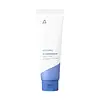What's inside
What's inside
 Key Ingredients
Key Ingredients

 Benefits
Benefits

 Concerns
Concerns

 Ingredients Side-by-side
Ingredients Side-by-side

Water
Skin ConditioningButylene Glycol
HumectantGlycerin
HumectantDiisostearyl Malate
EmollientDicaprylyl Ether
EmollientHydrogenated Poly(C6-14 Olefin)
EmollientBetaine
HumectantCetyl Ethylhexanoate
EmollientMethyl Trimethicone
Skin ConditioningC14-22 Alcohols
Emulsion StabilisingCetearyl Alcohol
EmollientGlyceryl Stearate Citrate
Emollient1,2-Hexanediol
Skin ConditioningStearic Acid
CleansingPolymethyl Methacrylate
Panthenol
Skin ConditioningHydroxyethyl Acrylate/Sodium Acryloyldimethyl Taurate Copolymer
Emulsion StabilisingAmmonium Acryloyldimethyltaurate/Vp Copolymer
Glyceryl Stearate
EmollientPalmitic Acid
EmollientArachidyl Alcohol
EmollientC12-20 Alkyl Glucoside
EmulsifyingAcetyl Glucosamine
Skin ConditioningBehenyl Alcohol
EmollientArachidyl Glucoside
EmulsifyingEthylhexylglycerin
Skin ConditioningCeramide NP
Skin ConditioningDisodium EDTA
Hydrogenated Lecithin
EmulsifyingSorbitan Isostearate
EmulsifyingDipropylene Glycol
HumectantThymol Trimethoxycinnamate
AntioxidantGluconolactone
Skin ConditioningGlucose
HumectantTocopherol
AntioxidantOenothera Biennis Oil
EmollientHydroxypropyl Bispalmitamide Mea
EmollientMannitol
HumectantCopernicia Cerifera Wax Extract
Acrylates/Ammonium Methacrylate Copolymer
Silica
AbrasiveArachidic Acid
CleansingCaesalpinia Sappan Stem Powder
ExfoliatingCholesterol
EmollientOleic Acid
EmollientWater, Butylene Glycol, Glycerin, Diisostearyl Malate, Dicaprylyl Ether, Hydrogenated Poly(C6-14 Olefin), Betaine, Cetyl Ethylhexanoate, Methyl Trimethicone, C14-22 Alcohols, Cetearyl Alcohol, Glyceryl Stearate Citrate, 1,2-Hexanediol, Stearic Acid, Polymethyl Methacrylate, Panthenol, Hydroxyethyl Acrylate/Sodium Acryloyldimethyl Taurate Copolymer, Ammonium Acryloyldimethyltaurate/Vp Copolymer, Glyceryl Stearate, Palmitic Acid, Arachidyl Alcohol, C12-20 Alkyl Glucoside, Acetyl Glucosamine, Behenyl Alcohol, Arachidyl Glucoside, Ethylhexylglycerin, Ceramide NP, Disodium EDTA, Hydrogenated Lecithin, Sorbitan Isostearate, Dipropylene Glycol, Thymol Trimethoxycinnamate, Gluconolactone, Glucose, Tocopherol, Oenothera Biennis Oil, Hydroxypropyl Bispalmitamide Mea, Mannitol, Copernicia Cerifera Wax Extract, Acrylates/Ammonium Methacrylate Copolymer, Silica, Arachidic Acid, Caesalpinia Sappan Stem Powder, Cholesterol, Oleic Acid
Water
Skin ConditioningPropanediol
SolventCaprylic/Capric Triglyceride
MaskingGlycerin
HumectantSqualane
EmollientCetearyl Alcohol
EmollientPolyglyceryl-10 Distearate
EmulsifyingGlyceryl Stearate
EmollientStearic Acid
CleansingDimethicone
Emollient1,2-Hexanediol
Skin ConditioningMyristoyl/Palmitoyl Oxostearamide/Arachamide Mea
Skin ConditioningPhytosterols
Skin ConditioningTocopheryl Acetate
AntioxidantCanola Oil
EmollientOlea Europaea Fruit Oil
MaskingCetyl Palmitate
EmollientSorbitan Palmitate
EmulsifyingSorbitan Olivate
EmulsifyingBisabolol
MaskingMethyl Caprooyl Tyrosinate
Skin ProtectingXanthan Gum
EmulsifyingSodium Hyaluronate
HumectantCarbomer
Emulsion StabilisingArginine
MaskingCaprylyl Glycol
EmollientWater, Propanediol, Caprylic/Capric Triglyceride, Glycerin, Squalane, Cetearyl Alcohol, Polyglyceryl-10 Distearate, Glyceryl Stearate, Stearic Acid, Dimethicone, 1,2-Hexanediol, Myristoyl/Palmitoyl Oxostearamide/Arachamide Mea, Phytosterols, Tocopheryl Acetate, Canola Oil, Olea Europaea Fruit Oil, Cetyl Palmitate, Sorbitan Palmitate, Sorbitan Olivate, Bisabolol, Methyl Caprooyl Tyrosinate, Xanthan Gum, Sodium Hyaluronate, Carbomer, Arginine, Caprylyl Glycol
Ingredients Explained
These ingredients are found in both products.
Ingredients higher up in an ingredient list are typically present in a larger amount.
1,2-Hexanediol is a synthetic liquid and another multi-functional powerhouse.
It is a:
- Humectant, drawing moisture into the skin
- Emollient, helping to soften skin
- Solvent, dispersing and stabilizing formulas
- Preservative booster, enhancing the antimicrobial activity of other preservatives
Cetearyl alcohol is a mixture of two fatty alcohols: cetyl alcohol and stearyl alcohol. It is mainly used as an emulsifier. Emulsifiers help prevent the separation of oils and products. Due to its composition, it can also be used to thicken a product or help create foam.
Cetearyl alcohol is an emollient. Emollients help soothe and hydrate the skin by trapping moisture.
Studies show Cetearyl alcohol is non-toxic and non-irritating. The FDA allows products labeled "alcohol-free" to have fatty alcohols.
This ingredient is usually derived from plant oils such as palm, vegetable, or coconut oils. There is debate on whether this ingredient will cause acne.
Due to the fatty acid base, this ingredient may not be Malassezia folliculitis safe.
Learn more about Cetearyl AlcoholGlycerin is already naturally found in your skin. It helps moisturize and protect your skin.
A study from 2016 found glycerin to be more effective as a humectant than AHAs and hyaluronic acid.
As a humectant, it helps the skin stay hydrated by pulling moisture to your skin. The low molecular weight of glycerin allows it to pull moisture into the deeper layers of your skin.
Hydrated skin improves your skin barrier; Your skin barrier helps protect against irritants and bacteria.
Glycerin has also been found to have antimicrobial and antiviral properties. Due to these properties, glycerin is often used in wound and burn treatments.
In cosmetics, glycerin is usually derived from plants such as soybean or palm. However, it can also be sourced from animals, such as tallow or animal fat.
This ingredient is organic, colorless, odorless, and non-toxic.
Glycerin is the name for this ingredient in American English. British English uses Glycerol/Glycerine.
Learn more about GlycerinGlyceryl Stearate is a mix of glycerin and stearic acid.
It is used to stabilize the mixing of water and oil ingredients. By preventing these ingredients from separating, it can help elongate shelf life. It can also help thicken the product's texture.
As an emollient, it helps soften skin and supports barrier-replenishing ingredients.
In cosmetics, Glyceryl Stearate is often made from vegetable oils or synthetically produced.
This ingredient may not be fungal-acne safe
Fun fact: The human body also creates Glyceryl Stearate naturally.
Learn more about Glyceryl StearateStearic Acid is a fatty acid. It is an emollient, emulsifier, and texture enhancer.
As an emollient, stearic acid helps soften skin. It aids the skin's protective barrier by preventing water loss. It also provides a gentle cleansing effect without stripping away natural oils.
Stearic acid may also be used to enhance the texture of products. It can add volume and stabilize ingredients such as water and oil. This can help water and oil ingredients from separating.
Sources of stearic acid include animal or vegetable fats/oils such as coconut or shea. It can be naturally found in butter, cocoa butter, shea butter, vegetable fats, and animal tallow.
This ingredient may not be Malassezia folliculitis, or fungal-acne safe.
Learn more about Stearic AcidWater. It's the most common cosmetic ingredient of all. You'll usually see it at the top of ingredient lists, meaning that it makes up the largest part of the product.
So why is it so popular? Water most often acts as a solvent - this means that it helps dissolve other ingredients into the formulation.
You'll also recognize water as that liquid we all need to stay alive. If you see this, drink a glass of water. Stay hydrated!
Learn more about Water